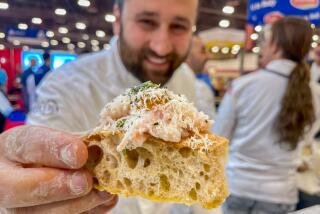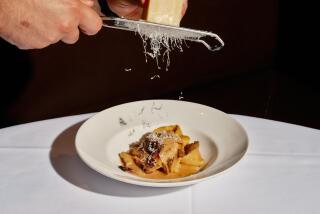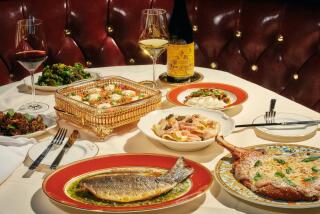All Dishes ‘Star’ in Full-Scale Italian-Style Meal : Menu: The five courses, from <i> antipasti</i> to <i> dolce</i> , do not include a “main course”; all are about equal in importance.
For most people who really like to eat, nothing is as much fun as dining Italian-style. Not only is each individual dish lively and colorful and bursting with flavor, but because of the way dishes are served, every dinner is a mini-adventure of pleasing contrasts.
A full-scale Italian meal consists of five courses: antipasti , primo , secondo , contorno and dolce . Not one of them is meant to be what Americans regard as a “main course”; rather, each is about equal in importance and interest. For the happy diner, that means there are five “star” dishes to look forward to, rather than just one. What could be better?
To illustrate how delightful this kind of dining can be, we’ve put together a menu that features one of our favorite Italian dishes as an example of each course. Naturally, you don’t have to serve all five in a single meal. Two or three of the dishes will mix and match just as pleasurably. Quantities given in the recipes will serve four people in the complete “five-star” meal.
Antipasti come in endless varieties. They can be fish, meat, vegetable, bread, egg and cheese--alone or in combination. Crostini are popular. These are simply slices of good country bread, lightly toasted in the oven and spread with something tasty--sometimes chicken liver pate , or a mince of ripe tomato, fresh basil and a dollop of fragrant olive oil. Just a few crostini pique the appetite nicely at the beginning of the meal. Our example uses a savory spread of tuna and white beans, perked up with a garnish of minced sweet onion.
The primo is the course Americans recognize as being most “Italian.” It can be pasta, risotto , gnocchi , a soup or even a small pizza. Pasta in all its fascinating shapes is probably the primo Italians most love, and they have an endless variety of sauces to serve with it.
This example is for spaghetti with a very quick-and-easy sauce of peppers, olives and a small amount of tomato. The sauce takes only 10 minutes to cook, and then the almost-cooked pasta is finished briefly in the sauce so it absorbs more flavor. (Done this way, the dish isn’t swimming in sauce; most of the tomato “sinks in,” leaving a juicy garnish of peppers and olives. In Italy, they like pasta more lightly dressed than Americans are accustomed to.)
The secondo in an Italian meal is most like our main course, but with all the other good things served before and after it, it’s usually a smaller portion than we’re used to. Quails are an ideal secondo . Two of the plump, tasty morsels are just the right size for a portion, and quails don’t need any elaborate preparation. Our recipe simply bakes them with sage leaves and bacon. (They’re even sweeter if you use pancetta , which is an unsmoked bacon available at Italian specialty shops.)
Contorni are the vegetable dishes that round out (contour) the secondo . They’re sometimes served after the secondo , sometimes alongside, but almost never on the same plate--a clear indication of how important it is to Italians to keep flavors sharp and distinct. Our example, fresh peas braised with a touch of tomato, has a bright acidity that contrasts nicely with the succulence of the quails. It’s a particularly good way to liven up peas that are a few days off the vine and no longer as sweet as fresh-picked ones.
Dolce , or dessert, is usually very simple in an Italian dinner. (Those elaborate cream pastries that Italian bakeries display are usually eaten as mid-morning or afternoon snacks, not with a meal.) Fresh fruit or a few cookies along with a cup of strong espresso coffee are generally enough.
Simple nut cakes are also very popular, such as our example of a hazelnut cake. Toasting the nuts in the oven intensifies their flavor, and for those who don’t care for whipped cream topping, a dusting of powdered sugar works well.
No meal in Italy would be complete without wine. If you want to serve just one wine with the whole meal, try a relatively light-bodied and slightly acidic red: a young Chianti (Badia a Coltibuono, Berardenga Felsina, Castello di Gabbiano, Fossi, San Polo in Rosso, Santa Cristina, Villa Banfi) or a Barbera, especially a Barbera d’Alba (Conterno, Giacosa, Fenocchio, Pio Cesare, Prunotto, Ratti, Vietti) would work perfectly.
If you’d rather start with a white and go on to a more assertive red, try a white Lacryma Christi (Mastro-berardino) or Verdicchio (Fazi-Battaglia, Garofoli, Monte Schiavo, Umani Ronchi), followed by a Dolcetto (Bovio, Ceretto, Cogno, Conterno, Pio Cesare, Prunotto, Vietti) or a Rosso di Montalcino (Altesino, Barbi, Caparzo, Col d’Orcia, Il Poggione) or an Italian Merlot from Friuli.
CROSTINI DI FAGIOLI E TONNO
(Tuscan Canapes of Tuna and Bean Pate)
1/2 cup canned white cannellini beans, drained
1/4 cup imported Italian tuna packed in olive oil (half of 6 1/2-ounce can)
1/2 to 3/4 cup minced mild onion
12 (3-inch) rounds white bread, crusts removed
Freshly ground black pepper
Rinse beans in sieve under running water. Drain well. Place beans, drained tuna and 1/4 cup onion into blender or food processor. Blend into smooth paste. (If it seems dry, add a little olive oil from tuna can.)
Toast bread rounds and spread with tuna-bean pate. Top with remaining chopped onion. Season to taste with pepper. Arrange on platter and serve. (Or place onion in small bowl to pass at table.) Makes 4 servings.
SPAGHETTI ALLA CIOCIARA
(Roman Country-Style Spaghetti)
1/2 cup olive oil
3/4 cup canned Italian-style plum tomatoes, drained
2 sweet red or green peppers, seeded and cut into 2x1/4-inch strips
1/4 pound black olives (oil-cured or Gaeta), pitted
Salt
Freshly ground pepper
1 pound Italian spaghetti
2 tablespoons freshly grated Pecorino Romano
Heat olive oil in skillet. Add tomatoes, peppers, olives, 1/2 teaspoon salt and several grindings pepper and mix well. Cook, covered, over medium heat 10 minutes, stirring occasionally. Remove from heat and set aside until pasta is ready.
Bring 4 quarts water and 1 tablespoon salt to boil. Add spaghetti and cook until slightly less than al dente. Return sauce to simmer. Drain pasta and add to sauce. Toss over medium heat 30 seconds. Add cheese and toss once more. Serve immediately. Makes 4 servings.
QUAGLIE AL FORNO
(Quails Baked With Butter and Sage)
8 quails, about 4 ounces each
8 slices blanched bacon (or Italian-style pancetta), about 4 ounces
3 tablespoons butter
3 fresh sage leaves or 1/2 teaspoon dried
Salt
Freshly ground pepper
1/3 cup dry white wine
Rinse quails and pat dry with paper towels. Place 1 slice bacon or pancetta over breast and thighs of each bird and tie securely with string.
Melt butter in oven-proof casserole just large enough to hold quails. Add sage leaves and quails and brown over medium heat, 3 to 4 minutes on each side. Season to taste with salt and pepper. Pour wine over birds.
Bake at 400 degrees 20 to 25 minutes, until tender, turning quails once after 10 minutes. Remove strings and serve in heated dish. Makes 4 servings.
PISELLI ALLA NAPOLETANA
(Neapolitan-Style Braised Peas)
2 1/2 tablespoons olive oil
1/4 cup chopped onion
2 pounds fresh peas, shelled (about 2 1/2 cups)
1 1/2 teaspoons tomato paste
2/3 cup hot water
1/4 teaspoon salt
Heat olive oil in heavy skillet over medium heat. Add onion and saute until tender, about 2 to 3 minutes. Add peas and cook, stirring, 2 minutes. Dissolve tomato paste in hot water and add to peas along with salt. Reduce heat to very low. Simmer, covered, 25 to 30 minutes, until peas are tender.
If any liquid remains, increase heat to high and boil rapidly, uncovered, until liquid evaporates. Serve immediately. Makes 4 servings.
More to Read
Eat your way across L.A.
Get our weekly Tasting Notes newsletter for reviews, news and more.
You may occasionally receive promotional content from the Los Angeles Times.










